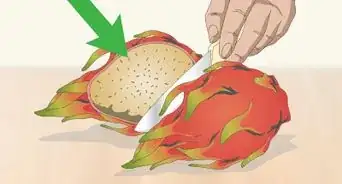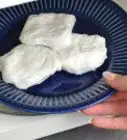This article was co-authored by wikiHow Staff. Our trained team of editors and researchers validate articles for accuracy and comprehensiveness. wikiHow's Content Management Team carefully monitors the work from our editorial staff to ensure that each article is backed by trusted research and meets our high quality standards.
The wikiHow Culinary Team also followed the article's instructions and verified that they work.
This article has been viewed 102,394 times.
Learn more...
Moisture or contaminants can cause your powdered food or spices to become clumpy and difficult to use. In the past, you may have even had to throw out lumpy powdered goods like cocoa, sugar, custard powder, dried milk, packet meals, and more. But before you toss your powdered food in the trash can, you may want to try breaking up lumps with a blender or food processor, by straining, or utilizing other preventative measures.
Steps
Using a Blender or Food Processor
-
1Transfer your lumpy powder into a blender or food processor. For food that is especially chunky, use your fingers or a tool, like a wooden spoon or ice pick, to break your powdered food into chunks that will fit easily in your blender or processor. After breaking up your powdered food, its ready to be blended/processed.
- If your powdered food is less clumpy and more powdery, it may be difficult to transfer it to your blender/processor. In this case, use a funnel to prevent spilling good powder.
- Use a tool, like a normal or wooden spoon, to guide your powdered food into the blender/processor from its container.
-
2Blend or process your powdered food. Reattach the lid of your blender or processor and fasten it tight. A poor lid seal could send your powdered food flying! Then you'll have to select the right blending/processing mode for your powder.
- Powdered food that is very lumpy might benefit from a lower speed setting, first. On some blenders/processors, this might be indicated as the "Stir" function.
- Your powdered food shouldn't require more than a short time at a medium speed to refine it back to its original, lumpless form.
- It is generally recommended, when using a blender/processor, to keep a hand on its top when running to prevent it coming loose.[1]
Advertisement -
3Return your powdered food to a clean container. You should prioritize a container that is airtight, as these will prevent opportunities for moisture cause more clumping. If you live in a humid climate or have regular issues with clumping, you might also want to store your powdered food in the freezer.
- The cold temperatures in your freezer will create a dry environment for your stored powdered food and reduce the formation of lumps.
-
4Use your powdered food. You can use your powdered food straight from the freezer. However, when baking, you may want to allow powdered ingredients to come to room temperature before using. Many times these recipes are created assuming all ingredients are at their normal temperature (e.g. - refrigerator cold milk/eggs, room temp sugar/flour, etc.).
- The temperature of the ingredients you use can influence the outcome of your recipe. If you're concerned the temperature of your powdered food might affect the outcome, it may be best to allow your ingredients to sit until they are room temperature.[2]
Straining Your Powdered Food
-
1Break up your powdered food. If moisture has made your powdered food blocky and chunky, you'll first need to break up the powder into smaller pieces. You may want to use a tool, like a wood spoon, metal spoon or ice pick to do this.
- Try to get the lumps in your food as small as possible. Aim to have no chunks larger than roughly the size of a marble. This will make the straining process easier on you.
-
2Strain your powdered food into a clean, dry container. Hold a thick tined, sturdy strainer over a clean, dry container. Then, a little bit at a time, add your lumpy powdered food to the strainer. Sift loose bits into the container and use a clean, dry tool, like a wooden spoon, to push lumps against and through the mesh of your strainer.[3]
- Try not to be too forceful when pushing lumps through the strainer. This could cause damage to the strainer.
- Some lumps may not break apart easily. In many cases, these will be unsalvageable and can be thrown away.
- Tiny lumps that are small enough to fit through the spaces of your sturdy strainer may remain in the mixture. This is ok.
- You may need to sift with your sturdy strainer a few times before your powdered food becomes consistent throughout. When you reach this point, you're ready to move on.
-
3Strain again with a fine mesh strainer. Take a fine mesh strainer and position it over a clean, dry container. Pour your powdered food a little bit at a time into the strainer and sift loose powder into the container below. Then, using a tool like a wooden spoon, push remaining clumps through the fine mesh to break them apart.
- Fine mesh strainers are usually a little more delicate than the thicker variety you used previously. Use light to moderate force to prevent breaking your strainer.
- If you notice lumps that stubbornly resist breaking up in your strainer, you should remove these and throw them away.
- You may need to strain your powdered food several times in your fine mesh strainer before it is consistent throughout and your lumps are broken up.
- Depending on how find your mesh strainer is, you may have very small lumps remaining in your powdered food. In this case, you can repeat the process with an even finer mesh strainer until all lumps are gone.
-
4Store your powdered food in a clean, dry container. Moisture is the major culprit that causes most clumping and lumping in food powders, so you may want to use an airtight container. Your powdered food is now ready for use.
Preventing Clumping
-
1Add a moisture absorber to your mix. As moisture causes most lumping in your powdered food, adding a moisture absorber, like dried rice or beans, to your mix prevents lumps from ever happening. Rice and beans are also relatively large, which means they'll be easy to pick out or can be caught easily in a shaker or strainer and separated from your food powder.
- While rice and beans are common moisture absorbers, many other things might be used, like unpopped popcorn.[4]
-
2Sift your powdered food regularly. You don't have to wait until lumps have formed to start sifting. Sifting aerates your food powder, releasing moisture that may be trapped inside it. Sifting your powdered food monthly and returning it to a clean, dry, airtight container will reduce occurrences of lumping.[5]
- If your powdered food has not started lumping yet, simply passing it through a fine mesh strainer and into a fresh, dry, airtight container should help keep it lumpless.
-
3Avoid applying powder over pans of hot food. Cooking food in a pan usually gives off steam, and steam is a form of moisture in the air. This moisture can rise from your pan to your shaker/container and get trapped there, creating future lumps.
- To prevent this from happening, you may want to first put your food powder in your hand or a spoon and then sprinkle it onto the food you are preparing.[6]
Things You'll Need
- Airtight container
- Blender or food processor
- Funnel (optional; recommended)
- Wooden spoon
Straining Your Powdered Food
- Airtight container
- Strainer (fine mesh)
- Strainer (sturdy, thick tined)
- Wooden spoon
Preventing Clumping
- Moisture absorber (dried beans or rice, for example)
- Strainer (fine mesh)
References
- ↑ http://www.blenderbuzz.com/control-and-settings-too-matter/
- ↑ http://thecakeblog.com/2016/06/does-ingredient-temperature-matter.html
- ↑ http://www.goodcooking.com/basic_ck.htm
- ↑ http://theboatgalley.com/stop-spices-from-clumping/
- ↑ http://joythebaker.com/2013/09/baking-101-must-we-sift-this-flour/
- ↑ http://theboatgalley.com/stop-spices-from-clumping/
























































